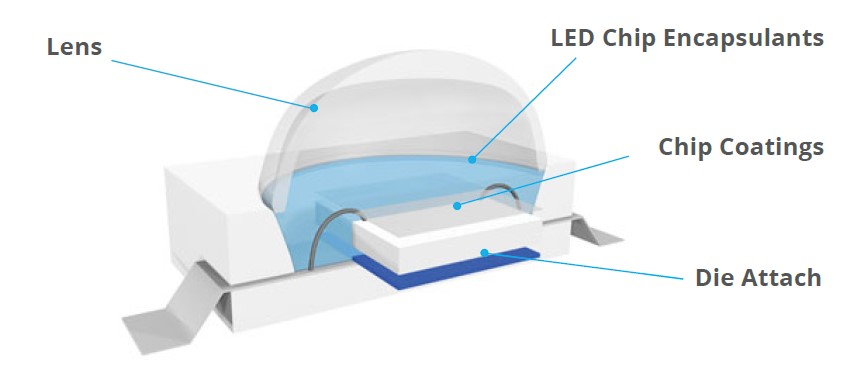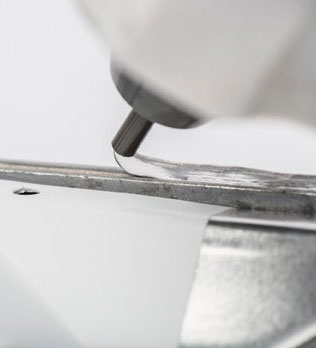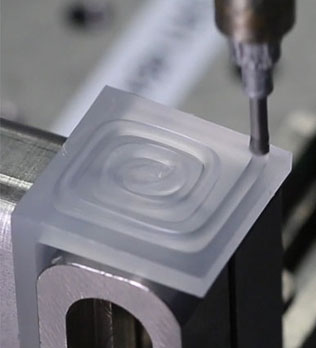Bonding Lenses to Housings in LED Lighting Using Hot Melt Silicones
 Tom Steucek
Tom Steucek
Engineering Sales Representative
Ellsworth Adhesives
New lighting assembly technology demands reliability and efficiency, as well as resistance to extreme temperatures, humidity, and harsh environmental conditions. LED lighting meets these requirements, becoming the preferred choice of many industrial manufacturers.
While LED lighting may require a higher upfront cost for customers, the long-term benefits often result in significant cost savings:
- Energy efficiency
- Lower long-term energy costs
- Extended life
- No infrared (IR) or ultraviolet radiation (UV)
- Reduced maintenance requirements
- Resistance to breakage
- Suitable for applications with rapid cycling
- Minimal glare
- Works well in high temperatures
Adhesives in LED Lighting
Adhesives play an important role in the assembly of LED lighting, providing strong bonds, thermal management, and protection against environmental contaminants. While different types of LED applications require different adhesive materials, it’s common to see a variety of products applied in a single application:
| Type of Specialty Chemical | Usage in LED Lighting Applications |
| Adhesives | Lends bonding, threadlocking, assembly |
| Conformal Coatings | Protective coatings for PCBs, internal drivers, and LED modules |
| Encapsulants | Encapsulating sensitive internal drivers, LED chips, lenses, and die attach |
| Sealants | Sealing out environmental contaminants (moisture, dust, etc.) |
| Thermal Interface Materials (TIMs) | Managing thermal energy and extending the life of electronic components |

Liquid optically clear adhesives (LOCAs) are often a top choice for LED lighting applications as they maintain or improve LED visual clarity. These are typically silicone adhesives or UV-curing urethane acrylic compounds with durable, high-performance attributes.
Creating Lens to Housing Bonds
The lens in an LED lighting apparatus doesn’t merely enclose the LED system, but plays a crucial role in how light from the light-emitting diode will focus or spread. Usually polycarbonate, the lens is attached to an aluminum base or housing which includes the inner light-emitting components of the system. Acrylics, polyurethanes, and urethanes are a standard pick for lens housing applications:
- An acrylic like Henkel Loctite AA 3462 performs well bonding glass to metal, which often covers an LED light.
- Considered a hybrid hot melt, SikaTack® Ultrafast is a high-viscosity polyurethane ideal for bonding glass to powder coated metal for outdoor light fixtures, or glazed automotive glass parts.
- Acrylated urethanes like Dymax E-MAX 904 can be used to bond a polycarbonate lens over an LED chip on a printed circuit board.

The Newest Player: Clear Hot Melt Silicones
Recently, clear hot melt silicone adhesives have entered the market offering unique benefits against comparable two-part adhesive systems:
- As a one component system, they require no mixing
- Very low cost compared to two component silicones, urethanes, or epoxies
- Good for high volume production (not ideal for small runs)
- Many offer secondary moisture cures which allow the adhesive to finish curing in shadowed areas
- Immediate pressure testing, boxing, and shipping due to high green strength
Dow is a major player in the clear hot melt silicone market for LEDs, offering two popular formulations: HM-2500 and HM-2510.

Dow DOWSIL™ HM-2500
Dow DOWSIL™ HM-2500 is a neutral cure RTV and reactive hot melt silicone designed as an assembly sealant that can be used with hot melt dispensing applicators and equipment.
The silicone is nonhazardous with a 15-minute open time, allowing for safe and easy assembly of LED lighting components. Its neutral cure ensures no release of acetic acid during the curing process, which can corrode electronic parts.
- Other benefits include:
No Work-in-Process (WIP) inventory, thanks to immediate green strength - 1,000% elongation after cure for extreme stress
- -45 to 150 °C service temperature

Dow DOWSIL™ HM-2510
Dow DOWSIL™ HM-2510 is a neutral cure hot melt silicone. With an open time of up to 15 minutes and a pot life of up to 24 hours, this sealant can be used with hot melt dispensing applicators and equipment. It is nonhazardous and safe to handle.
Other benefits include:
- No Work-in-Process (WIP) inventory, thanks to immediate green strength
- 1,900% elongation after cure for extreme stress
- -50 to 150 °C service temperature
The high green strength of each formulation allows parts to be handled quickly, an appealing advantage to any assembly line. Choosing between HM-2500 and HM-2510 will depend on your unique application needs and process requirements.
Dispensing Hot Melt Silicones
Choosing a material is just the beginning – proper adhesive application requires an investment in capital equipment. Typically, this includes a pail unloader (~$30k) and dispensing robot ($20k+). If your company isn’t equipped for automated hot melt silicone dispensing, Ellsworth Adhesives company Fisnar can help. As a world leader in industrial robots and automation solutions for fluid dispensing, Fisnar supplies a wide range of dispensing equipment compatible for LED bonding applications.